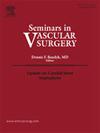老年人血液透析获取计划和结果
IF 2.4
3区 医学
Q1 PERIPHERAL VASCULAR DISEASE
引用次数: 0
摘要
在美国,终末期肾病(ESKD)的发病率正在稳步上升,老年人(即65岁及以上)是血液透析需求增长最快的人群。由于与年龄相关的合并症、虚弱和增加的手术风险,这种人口结构的转变带来了独特的挑战。尽管存在这些挑战,对于老年ESKD患者肾替代治疗的风险分层和管理的指导仍然有限。作者回顾了目前的文献和工具,以确定高风险老年ESKD患者的特征,重点是在计划永久性血液透析通道放置时的以下三个关键考虑因素:血管解剖、脆弱性和ESKD生命计划考虑因素。在老年患者中,我们讨论了病史和体格检查的重点领域、术前血管成像研究、血液透析通路类型、通路放置时间、使用的麻醉类型和多学科团队。我们的研究结果表明,采用一种系统的护理方法,结合这些关键因素,可能会为改善这一弱势群体的结局提供一条途径;然而,还需要进一步的研究。本文章由计算机程序翻译,如有差异,请以英文原文为准。
Hemodialysis access planning and outcomes in older adults
The rate of end-stage kidney disease (ESKD) is steadily rising in the United States, and older adults (ie, 65 years and older) represent the fastest-growing segment in need of hemodialysis. This demographic shift presents unique challenges due to age-related comorbidities, frailty, and increased procedural risks. Despite these challenges, there is limited guidance for risk stratification and management of renal replacement therapy in older patients with ESKD. The authors provide a review of current literature and tools to characterize high-risk older patients with ESKD, focusing on the following three key considerations when planning for permanent hemodialysis access placement: vascular anatomy, frailty, and ESKD Life-Plan considerations. Within this population of older patients, consideration of areas of focus for the history and physical examination, preoperative vascular imaging studies, hemodialysis access type, timing of access placement, type of anesthesia used, and multidisciplinary teams are discussed. Our findings suggest that applying a systematic approach to care that incorporates these key considerations may present a route for improving outcomes in this vulnerable population; however, further research is needed.
求助全文
通过发布文献求助,成功后即可免费获取论文全文。
去求助
来源期刊
CiteScore
3.50
自引率
4.00%
发文量
54
审稿时长
50 days
期刊介绍:
Each issue of Seminars in Vascular Surgery examines the latest thinking on a particular clinical problem and features new diagnostic and operative techniques. The journal allows practitioners to expand their capabilities and to keep pace with the most rapidly evolving areas of surgery.

 求助内容:
求助内容: 应助结果提醒方式:
应助结果提醒方式:


